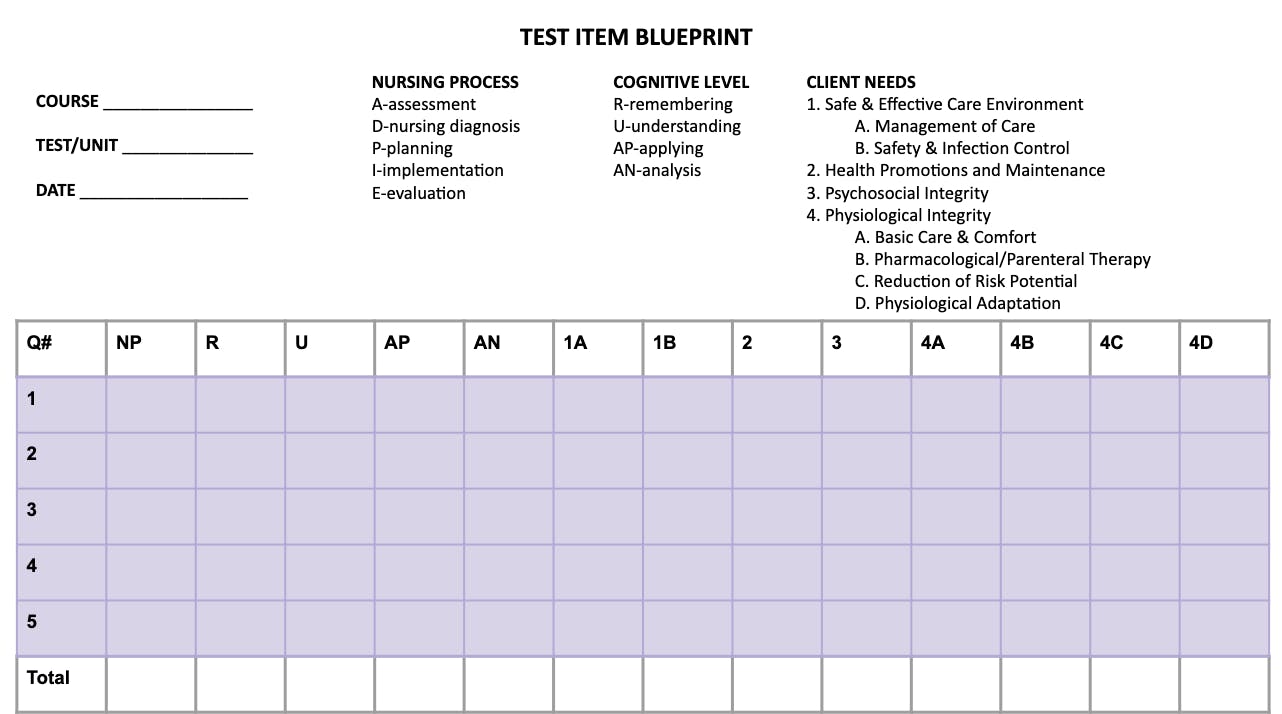Test Blueprinting in Nursing Education
by Kaplan Nursing | November 4, 2022

It is critical for nursing educators to stay up-to-date on trends and innovations in both nursing and teaching so that you can not only prepare your students to be successful on their board exams, but also in their careers in healthcare. As part of Kaplan’s commitment to providing comprehensive resources and support for educators, we were proud to partner with the World Health Organization and Nursing Now to provide mentorship opportunities for a select group of nurse educators during the Year of the Nurse Nightingale Challenge. Prior to beginning our Nightingale Challenge session on Test Blueprinting, the comfort level and experience of the nurse educator mentees was explored via a quick survey. It was discovered that more than half of the nurse educators surveyed either used test blueprinting inconsistently or not at all. Let’s take a closer look into how using test blueprinting in nursing education can benefit nursing faculty and students.
[Read next: Next Gen NCLEX® (NGN): Free Resources for Nursing Educators]
Frequently Asked Questions About Nursing Test Blueprints
Below, we address some frequently asked questions about using test blueprints in nursing education.
What is a nursing test blueprint?
There are thousands of ways to construct a home or building. Prior to starting a new project, an engineer will study a blueprint and envision what he/she wants the end product to look like. The blueprint serves to guide the construction and details of the building. Similarly, a test blueprint is the plan that nursing faculty create and use when “constructing/building” a test. It provides a plan for what the test will measure.
In order to make valid judgements about test scores, a test blueprint is advised as it incorporates a list of key components defining your tests. It reflects the content of an assessment that will be given to your students. A test blueprint can be used as a tool to guide faculty with aligning assessments of learners to the course objectives or student/program learning outcomes. Blueprints can also be used to help faculty be accountable for the education outcomes or instruction, ensuring that what is being taught is equitable to what is being tested. Lastly, blueprints can be used to assess validity of test scores (Patil, Gosavi, Bannur, & Ratnakar, 2015).
What is the purpose of using a test blueprint in nursing education?
Test blueprints serve a number of purposes in nursing education. They define parameters before faculty begin an assessment as well as review assessment for alignment to learning objectives. Test blueprints confirm content you’re planning to assess, which also can guide instructional activities and maximize examination validity. Not only are test blueprints beneficial for faculty and the curriculum, they can also be very resourceful for students. Blueprints that are shared with students will help guide their focus and study as they prepare for exams.
Why administer tests to nursing students?
We cannot discuss test blueprinting without discussing the purpose of a test. Tests are an instrument or procedure for describing characteristics of a student and are typically scored based on a number or percentage of answers. Tests are given in an effort to provide information about a learner's achievement of a course objective or mastery of an area of content. Tests can be used as a method to assess the learners’ knowledge and skills before and after instruction. Tests can also be used as a way to determine grades or admission into a program. Lastly, tests can be used to evaluate the effectiveness of course or program curriculum. By reviewing test results, faculty can identify content areas that students learned or did not learn in a course. With this information, faculty can modify the instruction to better meet student learning needs in future courses.
When tests are administered, they should require the students to think critically. Questions should be a mix of low and high order, as demonstrated in Bloom’s Taxonomy. Tests can also be a mix of short-answer essay questions, which test the ability of students to analyze information and draw conclusions. Take-home essay questions can be written specifically to enhance critical thinking. Questions that go beyond the lecture material drive students to use lecture notes, textbooks, and other resources to answer complicated questions.
How to Develop a Test Plan in Nursing Education
When developing a test plan, it is necessary for faculty to determine what pertinent information will be assessed and how many items/questions should be included on the test. Nursing educators need to also consider the style and level of questions that will be included as well as the anticipated time allotted for the learners to complete the test.
To ensure tests have representative content and objective sampling, a specified test plan should be part of course planning. Many faculty share responsibility for teaching a course; therefore, it is imperative that one person be appointed to coordinate the activities of the course so that tests are produced in a timely manner. When designing the semester’s tests, it is important to schedule tests in advance so the content covered is proportional to the weight of the test in the final grade.
The content and objectives measured should be representative of the period covered by the test. A blueprint is the mechanism that links the content and objective to the questions on a test.
Constructing the Nursing Test Blueprint
After developing the test plan, the next steps are to begin building the actual test blueprint. Consider using a template to easily identify which test questions correlate with the items deemed important to measure. A test blueprint can be simple, only measuring the unit/course, or it can include program objectives. It can also be even more complex by including components such as:
- The mapping of achievements of various components of the nursing process
- Client Needs categories based on the NCLEX test blueprint
- QSEN competencies
- Accreditation standards
The cognitive level as well as the type of questions can also be identified on a test blueprint.
Nursing Test Blueprint Templates
Here are a couple of nursing test blueprint templates to consider using as you get started.


Faculty should create test blueprints when “constructing/building” a test because blueprints help to:
- Guide the faculty in what will be measured on a test
- Align the tests to the learning objectives
- Guide instructional activities
- Maximize exam validity
They are also a great resource for students to help guide their focus and study as they prepare for exams. Test blueprints can help students identify what topics have greater emphasis. If you are new to developing test blueprints, start out small as you begin blueprinting your current tests/assessments. As you become more comfortable with the process, begin to add in more elements to measure.
Utilizing Test Blueprinting to Prepare Nursing Students for the NCLEX and Beyond
In the Kaplan Nursing white paper, “Utilizing Test Blueprinting to Prepare Nursing Students for the NCLEX and Beyond,” Shannon Meijer DNP, RN, and Dawn Oakley Whitfield, MSN, RN take a deep dive into the importance of assessment, the purpose of test blueprinting, and how to develop and implement test blueprints to assess clinical judgment and critical thinking skills.
DOWNLOAD "Utilizing Test Blueprinting to Prepare Nursing Students for the NCLEX and Beyond," to read the white paper.
The white paper offers detailed information and analysis about:
- Defining and unpacking the purpose of assessments and test blueprints
- How to use course content and learning objectives to guide blueprint development
- Examining test blueprint construction as a guide/map to develop assessments
- Ways in which test blueprinting will result in preparedness and success on the NCLEX and NGN
References
Abdellatif, H., & Al-Shahrani, A. M. (2019). Effect of blueprinting methods on test difficulty, discrimination, and reliability indices: cross-sectional study in an integrated learning program. Advances in Medical Education and Practice.
Brookhart, S. M., & Nikto, A. J. (2008). Assessment and grading in classrooms. Upper Saddle River, NJ: Pearson.
Eweda, G., Bukhar, Z. A., & Hamed, O. (2019). Quality assurance of test blueprinting. Journal of Professional Nursing.
Fliszar, R. (2009). Using assessment and evaluation strategies. In. R. A. Whittmann-Price & M. Godshall (Eds.), Certified nurse educator (CNE) review manual (pp. 89-116). New York, NY: Springer.
Patil, S. Y., Gosavi, M., Bannur, H. B., & Ratnakar, A. (2015). Blueprinting in assessment: A tool to increase the validity of undergraduate written examinations in pathology. International Journal of Applied Basic Medical Research.
Ray, M. E., Daugherty, K. K., Lebovitz, L., Rudolph, M. J., Shuford, V. P, & DiVall, M. V. (2018). Best practices on examination construction, administration, and feedback. American Journal of Pharmaceutical Education, 82(10), 1127-1132.
Valiga, T. M. (2017). Curriculum evaluation. In M. H. Oermann (Ed.), A systematic approach to assessment and evaluation of nursing programs (pp. 19-28). Philadelphia, PA: Wolters Kluwer.
Whittmann-Price, R. A. (2009). Facilitating Learning. In R. A. Whittmann-Price & M. Godshall (Eds.), Certified nurse educator (CNE) review manual (pp. 15-66). New York, NY: Springer.
Article Contributors
NCLEX® is a registered trademark of the National Council of State Boards of Nursing, Inc. Test names are the property of the respective trademark holders, none of whom endorse or are affiliated with Kaplan.
